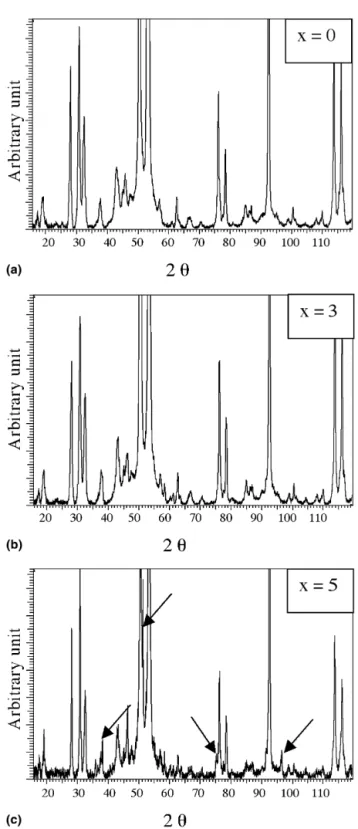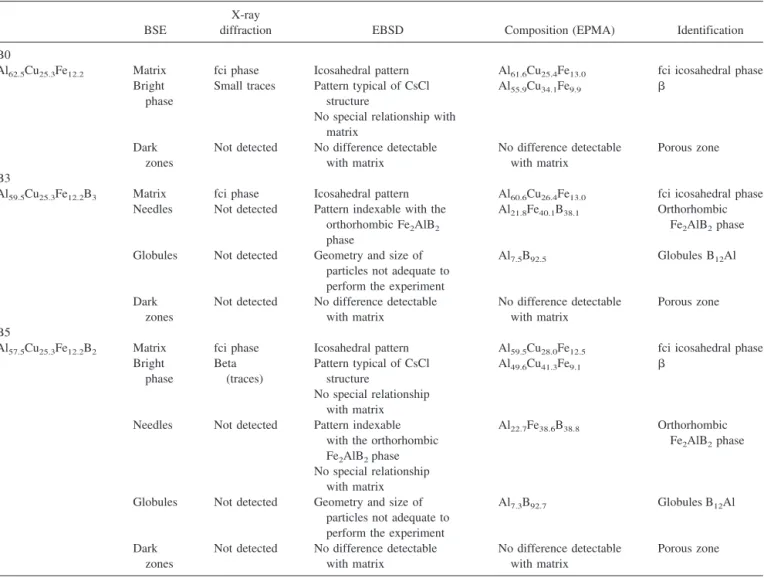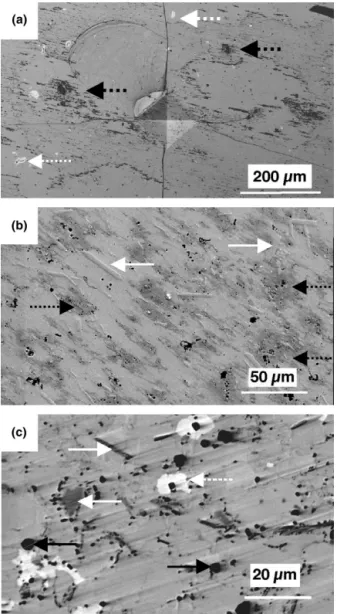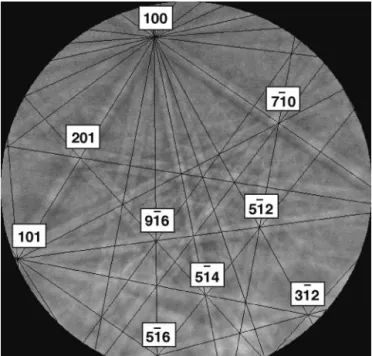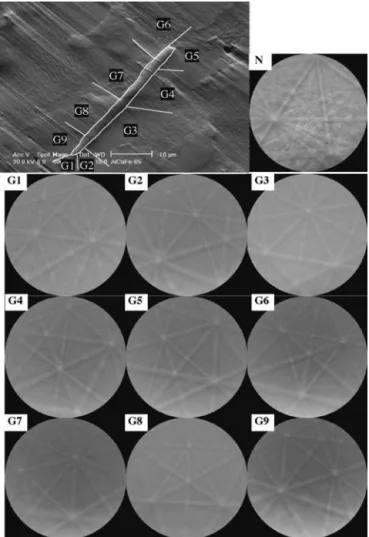HAL Id: hal-02882476
https://hal.archives-ouvertes.fr/hal-02882476
Submitted on 1 Jul 2020
HAL is a multi-disciplinary open access archive for the deposit and dissemination of sci-entific research documents, whether they are pub-lished or not. The documents may come from teaching and research institutions in France or abroad, or from public or private research centers.
L’archive ouverte pluridisciplinaire HAL, est destinée au dépôt et à la diffusion de documents scientifiques de niveau recherche, publiés ou non, émanant des établissements d’enseignement et de recherche français ou étrangers, des laboratoires publics ou privés.
Influence of boron content on the microstructure of
sintered Al62.5– xCu25.3Fe12.2B x alloys ( x = 0, 3, 5)
Valerie Brien, V. Khare, F. Herbst, P. Weisbecker, J-B. Ledeuil, M.C. de
Weerd, F. Machizaud, J-M. Dubois
To cite this version:
Valerie Brien, V. Khare, F. Herbst, P. Weisbecker, J-B. Ledeuil, et al.. Influence of boron content on the microstructure of sintered Al62.5– xCu25.3Fe12.2B x alloys ( x = 0, 3, 5). Journal of Materials Research, Cambridge University Press (CUP), 2004, 19 (10), pp.2974-2980. �10.1557/JMR.2004.0366�. �hal-02882476�
x V. Briena)and V. Khare
Laboratoire de Science et Génie des Matériaux et de Métallurgie, UMR 7584, CNRS-INPL-UHP, Parc de Saurupt, Ecole Nationale Supe´rieure des Mines de Nancy, 54042 Nancy Cedex, France
F. Herbst
Laboratoire de Sciences et Génie des Surfaces, UMR 7570, CNRS-INPL-EDF, Parc de Saurupt, ENSMN, 54042 Nancy Cedex, France
P. Weisbecker, J-B. Ledeuil, M.C. de Weerd, F. Machizaud, and J-M. Dubois
Laboratoire de Science et Génie des Matériaux et de Métallurgie, UMR 7584, CNRS-INPL-UHP, Parc de Saurupt, ENSMN, 54042 Nancy Cedex, France
(Received 7 May 2004; accepted 16 June 2004)
Microstructures and morphological features of a series of sintered quasicrystalline Al62.5−xCu25.3Fe12.2Bxalloys, with x ranging from 0 to 5 at.% were studied using x-ray diffraction, scanning electron microscopy, x-ray mapping, and electron probe microanalysis. Electron backscattering diffraction (EBSD) was also used to get
information about the structures of some phases and identify the crystalline relationship in-between phases. Increasing x results in the change of the nature of extra phases. These secondary phases are all less than 1% in volume of the total matter except for the  phase at 5% of boron. Whatever the percentage of boron considered, boron seems to concentrate essentially in the parasite phases confirming doubts found in literature about the solubility of boron inside the face-centered-icosahedral Al–Cu–Fe phase. No special crystallographic relationship in between the tested phases could be spotted. EBSD is thus also confirmed as an excellent technique to get quasicrystalline grains orientations.
I. INTRODUCTION
Quasicrystalline phases were discovered in 1984.1
The particular feature of this new class of materials is its unique tendency to crystallize according to nonperiodic crystallographic structures (icosahedral, decagonal …).1–3 These structures exhibit a long-range order that is not compatible with translation and impart a brand new com-bination of properties4–14to the material. This new com-bination of properties is as new as it is varied, consider-ing they are made of metallic atoms. Transport (thermal, electronic, optic …), tribological and thermodynamic properties have been widely investigated and found to be very original. Since this is a rather critical point for pos-sible industrial applications, their mechanical properties are also of high interest. Although these quasicrystalline intermetallic compounds can be plastically deformed at high temperature, they are very brittle at room tempera-ture. Their hardness is high and the toughness is rather low (Refs. 15–17 give data for the Al–Cu–Fe phase).
However, some work18
mentioned that the addition of boron to Al–Cu–Fe icosahedral quasicrystal helps to modify their fragility: while it simultaneously increases hardness values, addition of boron notably improves the fracture toughness of quasicrystalline coatings formed by plasma arc spraying. Different microstructural studies were performed in an attempt to understand such behav-ior. Sordelet et al.19have studied the related microstruc-tures of samples synthesized in a previous work.18They confirm observations mentioned by Huang et al.20 Solidification behavior and resulting microstructures strongly depend not only on the addition of boron (even in small amounts) but also on the process. Huang et al.20 tackled the case of melt spun ribbons (annealed or not) whereas Sordelet et al.19dealt with chilled cast and high-pressure gas atomized samples. It appears that the ap-pearance of secondary phases is systematic when adding boron to Al–Cu–Fe. It also turns out it is not clear whether boron is soluble in the ternary icosahedral phase or not. The study concerning the effect of a very small addition (x⳱ 0%, 0.5%, 1%, and 2%) on the solidifica-tion behavior of melt spun ribbons mensolidifica-tions that if boron has a solubility it should be very small.
a)
Address all correspondence to this author. e-mail: valerie.brien@lpmi.uhp-nancy.fr DOI: 10.1557/JMR.2004.0366
More work has then been undertaken here to study the effect of sintering and a presence of boron from 0 to 5 at.% on the morphology and structural modifications. The upper limit of the range was taken as 5 at.% B because it is known that the high-dimensional cubic lat-tice parameter of the Al–Cu–Fe—B compound decreases linearly with increasing boron concentration in melt-spun ribbons.21
The first part of the work focuses on a careful identi-fication of all the phases. The number of phases, their nature, and their morphology versus the increase of the percent of boron of the sintered samples were examined and reported here (Sec. III. A). Indeed, the ultimate goal of this investigation is to see if and how structural and morphological aspects can be linked with the mechanical properties of samples. This work is not presented here and will be the subject of later publications. Within this framework, attention has been taken to localize with pre-cision the chemical distribution of boron (Sec. III. B) and to identify the potential crystallographic relationships be-tween the present phases in samples (Sec. III. C).
II. EXPERIMENTS
T h r e e d i f f e r e n t a l l o y s h a v i n g c o m p o s i t i o n s Al62.5Cu25.3Fe12.2 (named B0), Al59.5Cu25.3Fe12.2B3
(named B3), and Al62.5Cu25.3Fe12.22B5(named B5) were
prepared by melting mixture of the constituent elements in an induction furnace in He atmosphere. These alloy ingots were then subjected to ball milling to achieve the required particle size (25–65m) for sintering process. Disks (4 mm thick and 30 mm diameter) of polygrained samples were prepared by this method. Sintering has been performed under Ar in a floating carbon matrix with an external pressure of 10 MPa for 1 h. The sintering temperature was selected after performing differential thermal analysis of the ball milled powder which varies from 750 to 800 °C depending upon the composition.
Scanned electron images with and without mixtures of secondary and backscattered electrons were performed on a Philips FEG XL30G. X-ray mapping was achieved either on a SX50 CAMECA microprobe or on the elec-tron dispersion spectroscopy (EDS) system adapted on a scanning electron microscope (SEM) Philips FEG XL30G. Phase compositions were obtained by electron probe microanalysis (EPMA) on a SX50 CAMECA microprobe. EPMA was also systematically performed to obtain the average composition of all phases found. To permit analysis of the presence of all elements (including the one of boron which is a delicate point) in phases, we used a voltage of 10 kV and an intensity of 15 nA. The SEM-FEG PHILIPS XL30G microscope was equipped with electron backscattering diffraction (EBSD).
EBSD is a technique used extensively nowadays to characterize textures and orientation relationships
between crystals. It can also be used for identifying struc-tures. EBSD performed on a single crystal or grain pro-duces a Kikuchi pattern. The Kikuchi pattern exhibits bands or parallel lines related to each crystallographic plane of the structure of the grain. The band sets exhibit the symmetry of the analyzed crystallographic structure.
FIG. 1. X-ray−2 diffraction patterns of sintered (a) B0, (b) B3, and (c) B5 samples recorded withCuK␣radiation. Arrows indicate peaks related to the presence of phase.
V. Brien et al.: Influence of boron content on the microstructure of sintered Al62.5−xCu25.3Fe12.2Bxalloys (x = 0, 3, 5)
Normal orientation of grains can then be determined and two grains exhibiting different orientations simply pro-duce different EBSD patterns. Naturally, “quasi-crystallography” is a recent tool studying quasicrystalline structures, and as automatic structural identification soft-ware is a recent development;automatic orientation iden-tification of such structures is not yet currently available, except at ETH-Zurich. However, qualitative and point analysis can be attempted. Visual appraisal and compari-son with standard Kikuchi maps can be carried out. Re-cent work obtained by Cheung et al.22 showed it was possible to record EBSD pattern on quasicrystalline structure. The EBSD patterns here were obtained by sub-tracting from the raw pattern an average background es-timated from a statistics of around 12 patterns of the same zone of the same sample.
For the sake of electron images and EBSD results, different states of surface were observed to determine the best final polishing procedure. The mirror polish-state was in most cases the one leading to optimal
observa-tions. Contrast of electron images (mixing or not second-ary and back-scattered electrons) is directly linked to the electron density of the material. The lighter the density is, the darker the image is.
III. EXPERIMENTAL RESULTS AND DISCUSSION A. Nature, morphology of present
phases, microstructures
The x-ray diffractograms of the sintered samples are reproduced in Fig. 1. Most of the peaks can be indexed in the face-centered icosahedral (fci) phase. Comparison of the peak positions on the 3 patterns reveals that no shift of lattice parameter can be detected with the introduction of boron. No secondary phase appears except on B5 dif-fractogram. This second phase can be indexed as the known phase (CsCl type) Al (Cu, Fe) and its peaks are marked by arrows. Table I is a compilation of all the information obtained from the different investigation techniques and provides an overview of results.
TABLE I. Table compiling results concerning the identification of phases.
BSE
X-ray
diffraction EBSD Composition (EPMA) Identification B0
Al62.5Cu25.3Fe12.2 Matrix fci phase Icosahedral pattern Al61.6Cu25.4Fe13.0 fci icosahedral phase Bright
phase
Small traces Pattern typical of CsCl structure
Al55.9Cu34.1Fe9.9  No special relationship with
matrix Dark
zones
Not detected No difference detectable with matrix
No difference detectable with matrix
Porous zone B3
Al59.5Cu25.3Fe12.2B3 Matrix fci phase Icosahedral pattern Al60.6Cu26.4Fe13.0 fci icosahedral phase Needles Not detected Pattern indexable with the
orthorhombic Fe2AlB2 phase
Al21.8Fe40.1B38.1 Orthorhombic Fe2AlB2phase Globules Not detected Geometry and size of
particles not adequate to perform the experiment
Al7.5B92.5 Globules B12Al
Dark zones
Not detected No difference detectable with matrix
No difference detectable with matrix
Porous zone B5
Al57.5Cu25.3Fe12.2B2 Matrix fci phase Icosahedral pattern Al59.5Cu28.0Fe12.5 fci icosahedral phase Bright phase Beta (traces) Pattern typical of CsCl structure Al49.6Cu41.3Fe9.1  No special relationship with matrix Needles Not detected Pattern indexable
with the orthorhombic Fe2AlB2phase
Al22.7Fe38.6B38.8 Orthorhombic Fe2AlB2phase No special relationship
with matrix Globules Not detected Geometry and size of
particles not adequate to perform the experiment
Al7.3B92.7 Globules B12Al
Dark zones
Not detected No difference detectable with matrix
No difference detectable with matrix
As it is not possible to detect secondary phases with a volume ratio less than 1% by x-ray diffraction. SEM/ back scattered electron microscopy (BSEM) was used to obtain more precise information. A study was carried out as far as possible and as long as necessary by x-ray mapping, EBSD, and EPMA to obtain, respectively, dis-tribution of elements for samples containing boron, struc-tural identification or eventual crystallographic relation-ship with the surrounding matrix, and compositions of phases.
Figure 2(a) presents a typical electron image recorded on the B0 sample (do not take notice of the pyramidal shape which is the signature of hardness testing for a further study). On top of the matrix, bright zones (of 10m size, white dotted arrows) and very dark zones
(D zones, of a few micrometers, indicated by black dot-ted arrows) can be spotdot-ted on top of the matrix. B0 is then not a pure icosahedral sample. A small composi-tional shift or a shift from the ideal temperature treatment is known to make the phase appear. A brighter contrast than the matrix contrast level indicates the secondary phase has a larger electronic density than the matrix. This one is compatible with the density of  as it contains more Cu and Fe than the icosahedral matrix. The analysis of the “white” grains by EBSD leads to patterns which are indexable using the CsCl structure confirming that the secondary phase is . The EBSD experiments also revealed that the grains were monocrystalline. As further polishing does not get rid of the dark zones, shaped like diffuse clouds, they cannot be dirt or local pollution. These zones of a lighter electron density exhibit an EBSD pattern identical to the one of the matrix and no difference of composition with the matrix (EPMA meas-urement); we can conclude they are due to the localized presence of porosity.
Figure 2(b) presents a typical electron image recorded on the B3 sample. As for the B0 sample, secondary phases can be observed. Porosity can also be spotted (dotted black arrows). The analysis of the D zones by EBSD and EPMA leads to identical results as for the B0 sample and rules out again the possibility of being boron rich zones. These porous zones often contain globules exhibiting a much darker contrast than the matrix sug-gesting a very light electron density (dark arrows). Most of the globules were found off their location, not polished or sectioned. Moreover, the sample exhibits scratches originating from the same locations. This proves they must be very stable and very hard. EPMA was performed taking into account the round shape of the rare but still present globules. The estimation of their composition gives AlB12. Because of the round shape, no EBSD
pat-tern could be recorded. Indeed the technique requires a planar and well-polished surface. The Inorganic Crystal Structure Database (ICSD) suggests different possibili-ties for the structure of such a composition: the globules might either be tetragonal (P 422) or monoclinic. From composition determination, it is clear that none of these structures can be an approximant of an Al–based quasi-crystalline phase. In accordance with their composition, these globules most presumably correspond to the icosa-hedral form of boron, stabilized by an aluminum atom sitting in the center of the boron icosahedral clusters. A second phase is present throughout the samples: it is a slightly darker contrast than the quasicrystalline matrix and exhibits a “needle” shape (Fig. 3, white arrows). Its chemical composition was delicate to perform as it un-derwent a preferential polishing making the needles set back from the surface of the matrix. Moreoever, the width of the needles is of the order of magnitude of the size of the EPMA probe (m). The estimate composition
FIG. 2. Electron images (most of electrons being BSE) of sintered Al–Cu–Fe-B alloys: (a) B0, (b) B3, and (c) B5 samples. White dotted arrows indicate the residual phase. Black ones indicate globules of phase lighter than the matrix (boron rich). Dotted black arrows indicate darker and diffuse zones of the matrix. White arrows point at the needles. Polishing is SiC paper 4000.
V. Brien et al.: Influence of boron content on the microstructure of sintered Al62.5−xCu25.3Fe12.2Bxalloys (x = 0, 3, 5)
then obtained was Fe2AlB2. The analysis indeed reveals
that copper would have no solubility in this phase. EBSD performed on needles proved that they all are monocrys-talline. The indexing of the obtained patterns as pre-sented in Fig. 3 was possible only by assuming the
Cmmm (65) base-centered orthorhombic Fe2AlB2
structure.
Figure 2(c) presents typical images recorded on the B5 sample. The x-ray diffraction pattern allows the
expectation of presence, which can be identified, under the light of the previous remarks, as being the phase exhibiting a bright contrast [dotted white arrows, Fig. 2(c)]. This was undoubtedly confirmed by indexing the EBSD patterns of these phases using the CsCl struc-ture. Its chemical composition measured by EPMA gave Al49.6Cu41.3Fe9.1. Needles, globules and dark zones
(re-spectively white, black and dotted black arrows) similar to the one studied in B0 or B3 samples can be seen. They all lead to similar results in terms of structure or chem-istry as in the studies performed for the two other samples. Boron (5 at.%) leads then to the presence of secondary phases: monocrystalline grains, monocrys-talline Fe2AlB2 needles, and some porous zones where
AlB12globules can be found.
B. Localization of boron
To complete the previous study and, more particularly, the point chemical EPMA analysis, x-ray mapping with the 4 constitutive elements Al, Cu, Fe, and B simulta-neously with and electron image (BSE) were recorded in B3 and B5 samples on representative zones (Fig. 4). These maps confirm boron is localized in globules in a high proportion and in the needles in a lower extent. These maps also confirm that the D zones are not boron-rich zones but porous zones, as no difference can be spotted with the matrix. Indeed, the B0 sample exhibits such zones and sintering is a preparation process known to be susceptible to produce porous zones. Detection of boron is very delicate. However, the very limited signals
FIG. 4. Indexed EBSD Kikuchi pattern recorded on a needle in B3 sample. Indexation could be done taking the Cmmm (65) structure, base-centered orthorhombic.
FIG. 3. BSE (top left) and x-ray maps recorded on (a) B3 and (b) B5 samples allowing a clear vizualization of the element distribution.
recorded in the matrices of the two samples indicate the Al–Cu–Fe icosahedral compound would have no solu-bility via this technique for boron. This result is not 100% certain. Indeed, the current limit of detection on these samples was estimated to 1 at.%. On the other hand, boron was shown to be present in secondary phases. The level of composition of boron in AlB12
and Fe2AlB2 and the quantity of globules and needles
observed suggests that very little or no boron is left in the matrix. It is therefore not certain whether boron enters the quasicrystalline structure. Several points establish this doubt. (i) No shift of parameter can be spotted on the x-ray diffraction patterns with increasing percent of bo-ron. (ii) X-ray mapping analysis shows no significant boron signal could be recorded in the matrix of samples containing 3 or 5 at.% boron with the analysis conditions used so far. (iii) B3 (Al59.5Cu25.3Fe13.2B3) and B5
(Al62.5Cu25.3Fe12.22B5) samples both contain impurity
phases other than the quasicrystalline one that all contain boron. Indeed B3 and B5 samples contain AlB12
glob-ules. (iv) B3 and B5 contains Fe2AlB2needles. All these
results support the idea that the solubility of boron in the icosahedral phase is non-existent or very small at (or close to) the thermodynamic equilibrium.
C. Orientation relationship between secondary phases and surrounding quasicrystalline grains
EBSD was attempted on the B3 SiC 4000 paper polished sample, and no pattern could be recorded coming from the needles. This was certainly due to work-hardening. Mirror polishing was then performed on all samples (carbon diamond paste, colloidal silica). Figure 5 gives the EBSD patterns of a needle and its surrounding quasicrystalline grains. As the available EBSD commercial indexing systems are programmed to index exclusively periodic crystals, no indexing of the icosahedral phases can automatically be performed yet. However, a glance at all these patterns shows they are all different and so shows the surrounding grains exhibit as many different orientations as they are in number. This leads us to conclude that no specific relationship between the needle and the icosahedral grains can be spotted. We found this result can be reproduced whatever the percent of boron is. Moreover, in the same way as for the needles, no special crystallographic relationship can be noticed between the grains and their surrounding qua-sicrystalline grains whatever the percent of boron is. One recalls that no EBSD pattern could be recorded on the AlB12globules because of their shape and size.
IV. CONCLUSION
A study looking at the influence of addition of boron on the microstructures of sintered Al–Cu–Fe-B samples has been carried out. Identification of the nature (composition-crystallographic structure) of constituting phases, their morphology, and their eventual relationship with the quasicrystalline matrix has been carried out. Boron (3% and 5%) leads to icosahedral material con-taining extra phases. The sample concon-taining 3% boron exhibits AlB12globules and Fe2AlB2 needles.
The sample containing 5% boron contains AlB12
globules, Fe2AlB2needles, and grains. The volume of
these extra phases (except for the phase at 5%) is less than 1%.
The Fe2AlB2 needles and the  grains do not have
specific crystallographic relationship with their sur-rounding quasicrystalline grains.
The study also stresses the success of the EBSD tech-nique for obtaining the grain orientations of quasicrys-talline grains. Sintering does not seem to favor a signifi-cant solubility of boron in the quasicrystalline structure.
ACKNOWLEDMENT
The authors wish to acknowledge the European Com-mission Growth 2000 Project No.
G5RD-CT-2001-FIG. 5. Results obtained on B3 sample. The top right image is a BSE image showing the studied needle called A (indicated by a white arrow). A is surrounded by 9 icosahedral grains AGi (i⳱ 1 to 9). Other images are the EBSD patterns of the AGi quasicrystalline grains
V. Brien et al.: Influence of boron content on the microstructure of sintered Al62.5−xCu25.3Fe12.2Bxalloys (x = 0, 3, 5)
00584 entitled Smart Quasicrystals for subsidizing the research.
REFERENCES
1. D. Shechtman, I. Blech, D. Gratias, and J-W. Cahn: Metallic phase with long-range orientational order and no translational symmetry. Phys. Rev. Lett. 53, 20 1951 (1984).
2. D. Levine and P.J. Steinhardt: Quasicrystals: A new class of or-dered structures. Phys. Rev. Lett. 53, 2477 (1984).
3. D. Levine and P.J. Steinhardt: Quasicrystals. I: Definition and structure. Phys. Rev. B 34, 596 (1986).
4. T. Klein, C. Berger, D. Mayou, and F. Cyrot-Lackman: Metallic phase with long-range orientational order and no translational symmetry. Phys. Rev. Lett. 66, 2907 (1991).
5. L. Bresson and D. Gratias: Plastic deformation in AlCuFe icosa-hedral phase. J. Non-Cryst. Solids 153–154, 468 (1993). 6. Y. Yokohama, T. Miura, A.P. Tsai, A. Inoue, and T. Masumoto:
Mater. Trans. JIM 33, 97 (1992).
7. D. Mayou, C. Berger, F. Cyrot-Lackman, T. Klein, and P. Lanco: Evidence for unconventional electronic transport in quasicrystals.
Phys. Rev. Lett. 70, 3915 (1993).
8. C. Janot: Quasicrystals, A Primer, 2nd ed. (Oxford Science Pub-lications, Oxford University Press, Oxford, U.K., 1994). 9. C. Berger: In Lectures on Quasicrystals 1994, edited by F. Hippert
and D. Gratias, (Les Editions de Physique, Les Ulis, 1994). 10. J. Von Stebut, C. Strobel, and J-M. Dubois: Friction response and
brittleness of polycrystalline Al–Cu–Fe icosahedral quasicrystals. In 5th International Conference on Quasicrystals (ICQ5), edited by C. Janot and R. Mosseri (World Scientific, Singapore, 1995). 11. S.S.L. Chang, W.B. Chin, C.M. Zhang, C.J. Jenks, and P.A. Thiel:
Oxygen adsorption on a single-grain, quasicrystal surface. Surf.
Sci. 337, 135 (1995).
12. S.J. Poon, F.S. Pierce, Q. Guo, and P. Volkov: Optical conductiv-ity of Al–based quasicrystals across metAl–insulator transition, in
5th International Conference on Quasicrystals (ICQ5), edited by
C. Janot and R. Mosseri (World Scientific, Singapore, 1995). 13. J-M. Dubois, P. Plaindoux, E. Belin-Ferré, N. Tamura, and
D.J. Sordelet: In Proceedings of the 6th International Conference
on Quasicrystals (1997), edited by S. Takeuchi and T. Fujiwara
(World Scientific, Singapore, 1998), p. 1267.
14. M. Gavatz, D. Rouxel, D. Claudel, P. Pigeat, B. Weber, and J-M. Dubois: Emissivity and oxidation of icosahedral Al62Cu25.5Fe12.5. In Proceedings of the 6th International
Confer-ence on Quasicrystals, edited by S. Takeuchi and T. Fujiwara,
World Scientific, Singapore 1267 (1998).
15. U. Koster, W. Liu, H. Liebertz, and M. Michel: Mechanical prop-erties of quasicrystalline and crystalline phases in Al–Cu–Fe al-loys. J. Non-Cryst. Solids. 416, 153 (1993).
16. P. Sainfort and B. Dubost: Micro-mechanical properties of bulk crystalline and quasicrystalline AlCuLi compounds. In
Quasicrys-talline Materials, edited by C. Janot and J.M. Dubois (World
Sci-entific, Singapore, 1988), p. 361.
17. E. Giacometti, N. Baluc, J. Bonneville, and J. Rabier: Microin-dentation of Al–Cu–Fe icosahedral quasicrystal. Scripta Mater.
41,989 (1999).
18. J.E. Shield, J.A. Campbell, and D.J. Sordelet: Mechanical proper-ties of Al–Cu–Fe-based quasicrystalline coatings. J. Mater. Sci.
Lett. 16, 2019 (1997).
19. D.J. Sordelet, T.A. Bloomer, M.J. Kramer, and O. Unal: Effects of boron on the solidification structure of an Al–Cu–Fe alloy.
J. Mater. Sci. Lett. 1, 11, (1996).
20. S.Y. Huang and J.E. Shield: Effect of boron additions on Al–Cu–Fe icosahedral quasicrystals. Philosophical Magazine 75, 157 (1997).
21. Y. Calvayrac et al. (private communication, 1998).
22. Y.L. Cheung, K.C. Chan, and Y.H. Zhu: Characterization of the icosahedral phase in as-cast quasicrystalline Al65Cu20Fe15 alloy.
